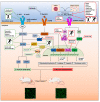Nutraceuticals and Exercise against Muscle Wasting during Cancer Cachexia
- PMID: 33255345
- PMCID: PMC7760926
- DOI: 10.3390/cells9122536
Nutraceuticals and Exercise against Muscle Wasting during Cancer Cachexia
Abstract
Cancer cachexia (CC) is a debilitating multifactorial syndrome, involving progressive deterioration and functional impairment of skeletal muscles. It affects about 80% of patients with advanced cancer and causes premature death. No causal therapy is available against CC. In the last few decades, our understanding of the mechanisms contributing to muscle wasting during cancer has markedly increased. Both inflammation and oxidative stress (OS) alter anabolic and catabolic signaling pathways mostly culminating with muscle depletion. Several preclinical studies have emphasized the beneficial roles of several classes of nutraceuticals and modes of physical exercise, but their efficacy in CC patients remains scant. The route of nutraceutical administration is critical to increase its bioavailability and achieve the desired anti-cachexia effects. Accumulating evidence suggests that a single therapy may not be enough, and a bimodal intervention (nutraceuticals plus exercise) may be a more effective treatment for CC. This review focuses on the current state of the field on the role of inflammation and OS in the pathogenesis of muscle atrophy during CC, and how nutraceuticals and physical activity may act synergistically to limit muscle wasting and dysfunction.
Keywords: bimodal approach; cancer cachexia; exercise; lifestyle interventions; muscle atrophy; muscle wasting; myokine; nutraceutical; nutrition.
Conflict of interest statement
The authors declare no conflict of interest. The funders had no role in the design of the study; in the collection, analyses, or interpretation of data; in the writing of the manuscript, or in the decision to publish the results.
Figures


References
Publication types
MeSH terms
Grants and funding
LinkOut - more resources
Full Text Sources
Other Literature Sources
Medical

